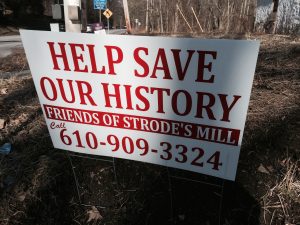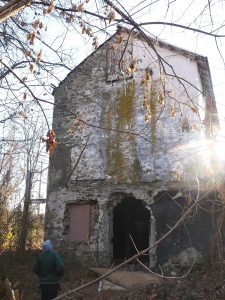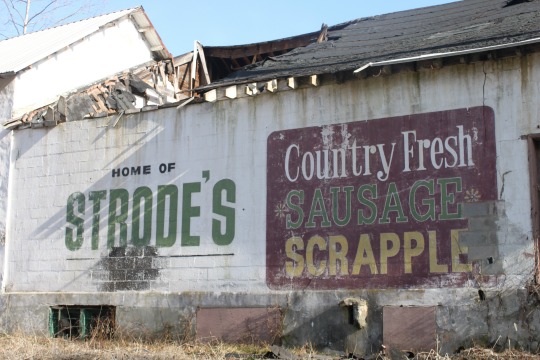The steady deterioration on the northeast corner of the Strode’s Mill Historic District - a village where George Washington’s troops procured grain from its mill - was too painful to ignore, an area preservationist recalled.
After repeatedly passing the intersection of Route 52 and Birmingham Road, Linda Kaat said she finally stopped her car there about five years ago. The parcel in decline had a for-sale sign. So Kaat wrote down the phone number, initiating a quest that has recently gained momentum.

The nearly seven-acre property, delineated by the gurgling Plum Run, may be best known for the faded letters that proclaim “Home of Strode’s Country Fresh Sausage, Scrapple.” But Kaat said the structures on it have historic resonance well beyond breakfast fare.
In addition to the Revolutionary War significance for the Americans, Kaat said the British forces marched past the crossroads on their way to the Battle of the Brandywine. Many properties in the village were owned for 250 years by members of the Strode family, whose myriad endeavors included operating the circa-1722 mill, running a timber business, producing pressed cider, farming, and serving as the village’s blacksmith/wheelwright.
Eventually, the family gained acclaim as the region’s premiere purveyor of pork products. In 1875, the Strodes operated a booth in the Market House in West Chester; in 1893 they expanded, opening one of the original stalls at the Reading Terminal Market in Philadelphia, according to the village's nominating petition for the National Register of Historic Places.
The Strode’s Mill Historic District earned National Register distinction in 1989. The petition championed the area as a thriving “crossroads village, providing a variety of services for the surrounding community and for people traveling toward Kennett and Concord.”

As she learned more about the history, Kaat said, “I got goose bumps.” She pointed out that numerous Revolutionary War notables had walked the grounds. “Washington’s soldiers who bought grain at the mill bled for our freedom … If that doesn’t make people feel that this area is significant, I don’t know what would,” she said.
On each corner of the crossroads sits a building significant to the village history, ranging from the Strode's Mill - longtime home of the Strode’s Mill Gallery - to the East Bradford Boarding School for Boys, now a private residence. The corner that Kaat targeted for rescue includes a two-story English-style stone barn, which is structurally sound; and a linear barn addition used for the sausage operation, which has fallen into critical disrepair.
Kaat envisions placing the land in conservation, preserving the barn, stabilizing the walls of the addition, creating an interpretive historic site with markers and signage, linking up with nearby trails, and adding a parking area.
Mirroring her efforts to preserve other historic sites in the area – a resume that includes the Glen Mills Train Station, Martin’s Tavern in Marshallton, and the Stargazers’ Stone in Newlin Township - Kaat began by picking up the phone.
She learned that Mark Rowan, a local developer, had owned the property since 1987 and wanted a higher price than Kaat could offer. Undaunted, she promised to call him back periodically to see if he might change his mind.

He didn’t, but Kaat said she developed a cordial relationship with him as well as his real-estate agent during her annual call-ins. She said she appreciated the fact that she was not the only one Rowan rebuffed. “I give him credit for turning down a lot of offers” that would have been unsuitable for the property, Kaat said.
When Rowan died in July 2013, Kaat began communicating with his brothers, Jay and Michael Rowan, who were handling the estate. She said they expressed support for her plan to turn the property into an educational resource, but it was already under an agreement of sale.
Kaat said she was thrilled "when the stars aligned” and the sale fell through this past fall. Realizing that many obstacles still blocked the purchase, she shifted her efforts into a higher gear. She formed the Friends of Strode's Mill and began setting up a 501(c)(3) for donations. She also got permission from the Rowans to put up a “Help Save Our History” sign on the property that lists her phone number.
So far, she has been thrilled with the response. She said she views her role as a “historic sparkplug,” a linchpin for a grassroots campaign similar to her 2009 effort to keep the Brandywine Battlefield open in the face of state budget cuts. “I hope these efforts light a spark that will get people involved,” she said. “The reward will be a site that will live on in the community and continue to tell its proud story.”
Last month, Kaat made a presentation to the East Bradford Township Supervisors. Since she had not worked with them previously, she forwarded letters of recommendation from other townships, including Birmingham, where she chaired “On Hallowed Ground,” a free event in May that included a sweeping Revolutionary War reenactment at Sandy Hollow park.

Kaat said she knew East Bradford had previously expressed interest in acquiring the tract, and she wanted to make sure the supervisors knew she would assist them if they still had that goal.
According to East Bradford Township's January minutes, the supervisors expressed general support for Kaat’s plan. However, they acknowledged a need to consult with their solicitor to see what, if any, role they could play in the disposition of the property. The sticking point? The township recently cited the estate for “demolition by neglect” after a portion of the old scrapple plant’s roof collapsed.
On Friday, Feb. 13, East Bradford Township Supervisors' Chairman Vincent Pompo said the board was working with its solicitor to resolve any problems. In the meantime, to avoid missing a deadline, the board passed a resolution on Tuesday, Feb. 10, to authorize the filing of a county grant application for the property, Pompo said. "We're very supportive of Linda's efforts," he said.
Donna Dymek, who runs the Strode’s Mill Gallery across the street, has witnessed the property's decline firsthand while framing artwork for members of the Wyeth family and the Brandywine River Museum of Art. “It’s very sad,” she said. “I’m definitely in favor of preserving it.”
Michael Rowan said he and his brother are equally eager for a resolution. He lamented the fact that the estate couldn't afford to donate the parcel. “We have a responsibility to ensure that bills are paid first,” he said.
He said the caved-in roof, a non-historic addition to the former slaughterhouse, would cost about $50,000 to repair, money the estate doesn’t have. Moreover, he explained that whoever purchases the property would have to turn around and tear it down.
“We really want to get this into the hands of someone who can do something positive with the property,” said Michael Rowan. “I think Linda’s idea is the one that would best serve the estate, the neighbors, and the township.”
His brother Jay echoed his comments. “I could not agree with that more,” he added.

Kaat’s career as a preservationist began in the ‘80s with the acquisition of Sweetwater Farm in Glen Mills, a wedding gift from her husband, Jim Kaat, a former Phillies pitcher and baseball broadcaster. Kaat turned a 250-year-old relic into a coveted bed-and-breakfast, and although the marriage ended, Kaat solidified her ability to transform a tired, tarnished piece of history into a jewel.
“A guardian angel with history in his veins who wants to step forward” and fund the Strode project would certainly be welcomed, said Kaat. But in the absence of a principal donor, the project could come to fruition with many small contributions, she said.
Kaat, who lives in Marshallton, said her sentiments are in synch with a quote from a 2007 report by the National Park Service: “We preserve these sites so that our national history may continue as a living presence.”
What Kaat described as a “fun-raiser” will be held Friday, Feb. 20, from 6 to 9 p.m. She said it would provide an opportunity for people interested in joining the effort to learn more and interact with members of the group. Because it is being held at a private residence in Radley Run Mews, about a mile from Strode’s Mill, RSVPs are requested by Thursday, Feb. 19.
For details, visit www.friendsofstrodesmill.com or the group’s Facebook page: https://www.facebook.com/friendsofstrodesmill.




Comments